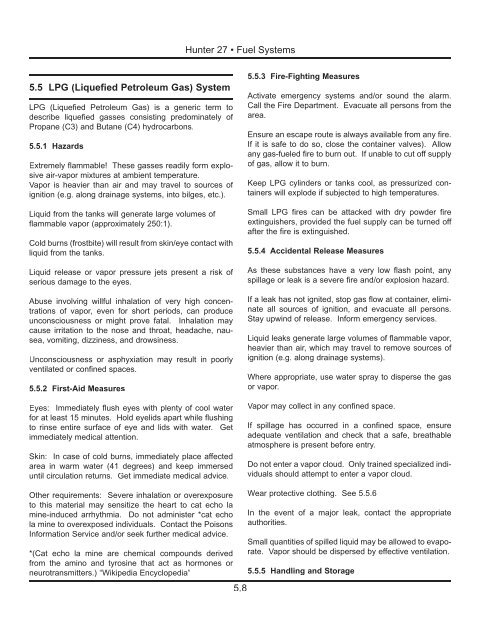27 Operator's Manual.. - Marlow-Hunter, LLC
27 Operator's Manual.. - Marlow-Hunter, LLC
27 Operator's Manual.. - Marlow-Hunter, LLC
You also want an ePaper? Increase the reach of your titles
YUMPU automatically turns print PDFs into web optimized ePapers that Google loves.
<strong>Hunter</strong> <strong>27</strong> • Fuel Systems<br />
5.5 LPG (Liquefied Petroleum Gas) System<br />
LPG (Liquefied Petroleum Gas) is a generic term to<br />
describe liquefied gasses consisting predominately of<br />
Propane (C3) and Butane (C4) hydrocarbons.<br />
5.5.1 Hazards<br />
Extremely flammable! These gasses readily form explosive<br />
air-vapor mixtures at ambient temperature.<br />
Vapor is heavier than air and may travel to sources of<br />
ignition (e.g. along drainage systems, into bilges, etc.).<br />
Liquid from the tanks will generate large volumes of<br />
flammable vapor (approximately 250:1).<br />
Cold burns (frostbite) will result from skin/eye contact with<br />
liquid from the tanks.<br />
Liquid release or vapor pressure jets present a risk of<br />
serious damage to the eyes.<br />
Abuse involving willful inhalation of very high concentrations<br />
of vapor, even for short periods, can produce<br />
unconsciousness or might prove fatal. Inhalation may<br />
cause irritation to the nose and throat, headache, nausea,<br />
vomiting, dizziness, and drowsiness.<br />
Unconsciousness or asphyxiation may result in poorly<br />
ventilated or confined spaces.<br />
5.5.2 First-Aid Measures<br />
Eyes: Immediately flush eyes with plenty of cool water<br />
for at least 15 minutes. Hold eyelids apart while flushing<br />
to rinse entire surface of eye and lids with water. Get<br />
immediately medical attention.<br />
Skin: In case of cold burns, immediately place affected<br />
area in warm water (41 degrees) and keep immersed<br />
until circulation returns. Get immediate medical advice.<br />
5.5.3 Fire-Fighting Measures<br />
Activate emergency systems and/or sound the alarm.<br />
Call the Fire Department. Evacuate all persons from the<br />
area.<br />
Ensure an escape route is always available from any fire.<br />
If it is safe to do so, close the container valves). Allow<br />
any gas-fueled fire to burn out. If unable to cut off supply<br />
of gas, allow it to burn.<br />
Keep LPG cylinders or tanks cool, as pressurized containers<br />
will explode if subjected to high temperatures.<br />
Small LPG fires can be attacked with dry powder fire<br />
extinguishers, provided the fuel supply can be turned off<br />
after the fire is extinguished.<br />
5.5.4 Accidental Release Measures<br />
As these substances have a very low flash point, any<br />
spillage or leak is a severe fire and/or explosion hazard.<br />
If a leak has not ignited, stop gas flow at container, eliminate<br />
all sources of ignition, and evacuate all persons.<br />
Stay upwind of release. Inform emergency services.<br />
Liquid leaks generate large volumes of flammable vapor,<br />
heavier than air, which may travel to remove sources of<br />
ignition (e.g. along drainage systems).<br />
Where appropriate, use water spray to disperse the gas<br />
or vapor.<br />
Vapor may collect in any confined space.<br />
If spillage has occurred in a confined space, ensure<br />
adequate ventilation and check that a safe, breathable<br />
atmosphere is present before entry.<br />
Do not enter a vapor cloud. Only trained specialized individuals<br />
should attempt to enter a vapor cloud.<br />
Other requirements: Severe inhalation or overexposure<br />
to this material may sensitize the heart to cat echo la<br />
mine-induced arrhythmia. Do not administer *cat echo<br />
la mine to overexposed individuals. Contact the Poisons<br />
Information Service and/or seek further medical advice.<br />
*(Cat echo la mine are chemical compounds derived<br />
from the amino and tyrosine that act as hormones or<br />
neurotransmitters.) “Wikipedia Encyclopedia”<br />
5.8<br />
Wear protective clothing. See 5.5.6<br />
In the event of a major leak, contact the appropriate<br />
authorities.<br />
Small quantities of spilled liquid may be allowed to evaporate.<br />
Vapor should be dispersed by effective ventilation.<br />
5.5.5 Handling and Storage

















